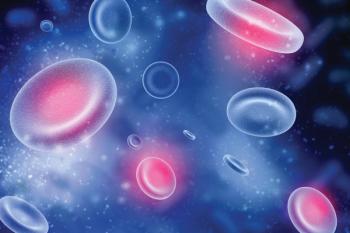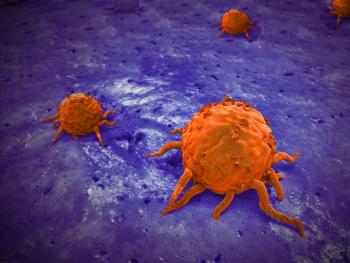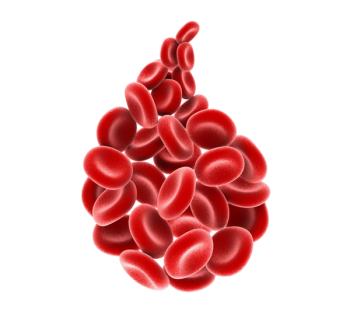
Adjuvant Osimertinib Yields Promising Reduction in Risk of Recurrence or Death in EGFR+ Stage IB-IIIA NSCLC
Findings from the phase 3 ADURA trial indicated that patients with EGFR-mutated, stage II to IIIA non–small cell lung cancer (NSCLC) experienced a promising reduction in risk of disease recurrence or death following treatment with adjuvant osimertinib.
A 77% reduction in risk of disease recurrence or death, as well as an improved disease-free survival were observed following adjuvant treatment with osimertinib (Tagrisso) in patients with EGFR-mutant, stage II to IIIA non–small cell lung cancer (NSCLC) regardless of previous adjuvant chemotherapy or staging, according to updated data from the phase 3 ADAURA trial (NCT02511106).1
Data presented during the 2022 ESMO Congress showed that at a median follow-up of 44.2 months (range, 0-67) with osimertinib (n = 233) and 19.6 months (range, 0-70) with placebo (n = 237), the median DFS was 65.8 months (95% CI, 54.4–not calculable [NC]) vs 21.9 months (95% CI, 16.6-27.5), respectively, in the population of patients with stage II/IIIA disease (hazard ratio [HR], 0.23; 95% CI, 0.18-0.30).
In the overall population, osimertinib (n = 339) resulted in a median DFS of 65.8 months (95% CI, 61.7-NC) vs 28.1 months (95% CI, 22.1-35.0) with placebo (n = 343), translating to a 73% reduction in the risk of disease recurrence or death (HR, 0.27; 95% CI, 0.21-0.34). In this group, the median follow-up for those who received osimertinib was 44.2 months (range, 0-69) and 27.7 months (range, 0-70) for those given placebo.
Notably, the DFS benefit provided by osimertinib over placebo was observed across all predefined subgroups. In those who received prior adjuvant chemotherapy (n = 410), the HR for DFS was 0.29 (95% CI, 0.21-0.39); the HR was 0.36 (95% CI, 0.24-0.55) in those who did not (n = 272). The HRs for those with stage IB (n = 212), stage II (n = 236), and stage IIIA (n = 234) disease per American Join Committee on Cancer (AJCC)/Union for International Cancer Control (UICC) 7th edition criteria were 0.41 (95% CI, 0.23-0.69), 0.34 (95% CI, 0.23-0.52), and 0.20 (95% CI, 0.14-0.29), respectively.
In a presentation at the congress, lead study author Masahiro Tsuboi, MD, of the Department of Thoracic Surgery and Oncology at the National Cancer Center Hospital East in Kashiwa, Japan, added that the DFS benefit observed with osimertinib across disease stages was consistent following re-staged based on the AJCC/UICC 8th edition manual. In those with stage IB, II, and IIA disease, the HRs for DFS were 0.44 (95% CI, 0.25-0.76), 0.33 (95% CI, 0.21-0.50), and 0.22 (95% CI, 0.15-0.31), respectively.
“These updated data reinforce adjuvant osimertinib as the standard of care for patients with EGFR-mutated, stage IB to IIA NSCLC after complete tumor resection, with or without adjuvant chemotherapy,” Tsuboi said.
Patients who were at least 18 years of age (or at least 20 years of age in Japan/Taiwan) who had a World Health Organization (WHO) performance status of 0 or 1 and confirmed primary nonsquamous NSCLC with EGFR exon 19 deletion or L858R mutation were enrolled to ADAURA. Patients must have undergone a complete resection with negative margins.
The maximum interval between surgery and randomization on the trial was 10 weeks without adjuvant chemotherapy and 26 weeks with adjuvant chemotherapy.
Key stratification factors comprised disease stage (IB vs II vs IIIA), EGFR mutational status (exon 19 deletion vs L858R), and race (Asian vs non-Asian).
A total of 682 participants were randomly assigned to receive osimertinib at a once-daily dose of 80 mg or placebo administered, also administered once daily. The planned treatment duration for these patients was 3 years, and treatment continued until disease recurrence, treatment was completed, or discontinuation criterion were met.
Investigator-assessed DFS in patients with stage II/IIIA disease served as the primary end point of the trial; this was designed for superiority under the assumed HR of 0.70 for DFS. Important secondary end points included DFS in the overall population; DFS at 2, 3, 4, and 5 years; overall survival; safety; and health-related quality of life. Prespecified exploratory end points included patterns of recurrence and time to central nervous system (CNS) disease recurrence or death (CNS DFS).
In December 2020, the
At the
Demographics and baseline patient characteristics were generally balanced between the investigative and control arms, according to Tsuboi.
The median age of those in the osimertinib arm was 64 years (range, 30-86) vs 62 years (range, 31-82) of those in the placebo arm; 68% and 72% of patients, respectively, were female. Moreover, the majority of patients across the osimertinib and placebo arms did not have a smoking history (68% vs 75%, respectively), were Asian (64% vs 64%), had a WHO performance status of 0 (63% vs 64%), a histology of adenocarcinoma (96% vs 97%), and received adjuvant chemotherapy (60% vs 60%).
Notably, the proportion of disease stages was comparable when participants were restaged by the AJCC/UICC 8th edition staging manual.
Additional data presented during the meeting showed that in the population of patients with stage II/IIIA disease, the 24-month DFS rates with osimertinib and placebo were 90% and 46%, respectively; at 36 months, these rates were 84% vs 34%, respectively, and 70% vs 39%, respectively, at 48 months. In the overall population, the 24-, 36-, and 48-month DFS rates in the osimertinib and placebo arms were 90% and 55%, respectively; 85% and 44%, respectively; and 73% and 38%, respectively.
In the overall population, fewer patients who received osimertinib experienced disease recurrence than those who received placebo, at 27% (n = 93/339) and 60% (n = 205/343), respectively. The most frequent first sites of recurrence in the osimertinib arm were the lung (12%), lymph nodes (6%), and the CNS (6%); in the placebo arm, the most frequent sites were also the lung (26%), lymph nodes (17%), and CNS (11%).
A total of 63 patients experienced CNS DFS events; 22 of these patients were in the osimertinib arm and 41 were in the placebo arm. Fourteen percent and 71% of patients in the osimertinib and placebo arms, respectively, were on treatment at the time of CNS recurrence.
The median CNS DFS was not reached (95% CI, 65.8-NC) in the osimertinib arm and not reached (95% CI, NC-NC) in the placebo arm (HR, 0.24; 95% CI, 0.14-0.42). The 24-month CNS DFS rate in the osimertinib and placebo arms were 98% and 81%, respectively; at 36 months, these rates were 97% and 77%, respectively, and at 48 months, these rates were 90% and 75%, respectively.
The estimated probability of observing CNS recurrence at 36 months in the osimertinib and placebo arms was 2% (95% CI, 0.9%-5.0%) and 13% (95% CI, 8.5%-18.5%), respectively. The cumulative incidence of CNS recurrence proved to be consistently lower in the investigative arm vs the placebo arm, according to Tsuboi.
“The safety profile was consistent with the established safety profile of osimertinib, and no new safety concerns were reported with an extended treatment duration,” Tsuboi said.
Regarding safety, 66% of those on osimertinib completed the planned duration of treatment of 3 years vs 41% of those on the placebo arm. The median total duration of exposure to osimertinib was 35.8 months (range, 0-38) and 25.1 months (range, 0-39) to placebo.
Any-grade adverse effects (AEs) occurred in 98% of those on the osimertinib arm (n = 337) vs 90% of those on the placebo arm (n = 343); these effects were grade 3 or higher in 23% and 14% of patients, respectively. Serious AEs occurred in 20% of those who received osimertinib and 14% of those who were given placebo.
Moreover, 13% of those on the investigative arm vs 3% of those on the control arm experienced an AE that led to discontinuation; 12% and 1% of patients, respectively, had an AE that led to dose reduction, and 27% and 13% of patients, respectively, had an AE that led to dose interruption. One patient in the osimertinib arm and 2 patients in the placebo arm experienced an AE that resulted in death.
AEs that were potentially causally related to treatment occurred in 91% and 58% of patients in the osimertinib and placebo arms, respectively; these effects were grade 3 or higher in 11% and 2% of patients, respectively. Three percent of patients in the osimertinib arm and 1% of those in the placebo arm experienced a serious toxicity.
Interstitial lung disease was reported in 3% of those in the osimertinib arm, and all cases were grade 1 or 2 in severity. QTc prolongation was observed in 9% and 2% of patients in the osimertinib and placebo arms, respectively.
Next steps for further research with osimertinib will focus on learning more about treatment duration, subsequent treatment use, and OS benefit.
In the global phase 3 ADAURA2 trial (NCT05129349), investigators will further evaluate the effects of osimertinib in patients with EGFR-mutated, stage IA2 to IA3 NSCLC following tumor resection.
References
- Tsuboi M, Wu Y0L, Grohe C, et al. Osimertinib as adjuvant therapy in patients (pts) with resected EGFR-mutated (EGFRm) stage IB-IIIA non-small cell lung cancer (NSCLC): updated results from ADAURA. Ann Oncol. 2022;33(suppl 7):S808-S869. doi:10.1016/annonc/annonc1089
- FDA approves osimertinib as adjuvant therapy for non-small cell lung cancer with EGFR mutations. FDA. News release. December 18, 2020. Accessed September 11, 2022.
http://bit.ly/2KE54v6 - Wu Y-L, Tsuboi M, He J, et al. Osimertinib in resected EGFR-mutated non-small-cell lung cancer. N Engl J Med. 2020;383(18):1711-1723. doi:10.1056/NEJMoa2027071
Newsletter
Stay up to date on recent advances in the multidisciplinary approach to cancer.



















































































